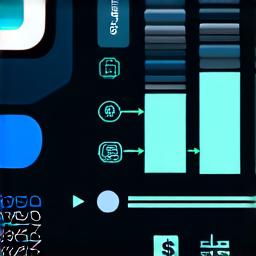Introduction
The blockchain is an innovative technology that has revolutionized the way we think about money and finance. It’s a decentralized, distributed ledger that allows for secure and transparent transactions without the need for intermediaries like banks or payment processors. In this article, we will delve into how money moves in the blockchain, exploring its key features, benefits, and challenges.
Key Features of Money in the Blockchain
1. Decentralization
One of the key features of money in the blockchain is that it’s decentralized. This means that there’s no central authority controlling the flow of funds or setting transaction rules. Instead, transactions are validated and verified by a network of nodes that work together to maintain the integrity of the ledger.
2. Immutability
Another important feature of money in the blockchain is immutability. Once a transaction is recorded on the ledger, it cannot be altered or deleted. This creates a tamper-proof record of all financial transactions and ensures that funds can’t be double-spent or stolen.
3. Transparency

The blockchain provides complete transparency of all financial transactions. Every transaction is recorded on the public ledger, which can be accessed by anyone with an internet connection. This makes it easier to track the movement of funds and prevent fraudulent activities.
4. Security
Thanks to its decentralized nature, the blockchain is highly secure. Because there’s no single point of failure, it’s much more difficult for hackers to compromise the system. Additionally, each transaction is encrypted and secured with a unique cryptographic hash, which makes it virtually impossible to tamper with the ledger.
Benefits of Money in the Blockchain
1. Faster and Cheaper Transactions
One of the biggest benefits of money in the blockchain is that it allows for faster and cheaper transactions. Because there are no intermediaries involved, funds can be transferred instantly and at a much lower cost than traditional banking methods.
2. Improved Access to Financial Services
The blockchain has the potential to improve access to financial services for people who are currently underserved or excluded from the traditional banking system. By allowing anyone with an internet connection to participate in the network, it can help bridge the gap between those who have access to financial services and those who don’t.
3. Increased Efficiency
Money in the blockchain is highly efficient because it eliminates the need for intermediaries and streamlines the transaction process. This can lead to significant cost savings for businesses and individuals, as well as increased productivity and efficiency.
4. Enhanced Privacy
The blockchain provides enhanced privacy by allowing users to maintain anonymity while making transactions. This can be especially important in situations where privacy is a concern, such as online marketplaces or peer-to-peer lending platforms.
Challenges of Money in the Blockchain
1. Regulatory Challenges
One of the biggest challenges facing money in the blockchain is regulatory uncertainty. Because the technology is still relatively new, there’s a lack of clear guidelines and regulations governing its use. This can create confusion and uncertainty for businesses and individuals who are looking to adopt the technology.
2. Scalability Challenges
Another challenge facing money in the blockchain is scalability. As the number of users on the network grows, the transaction processing speed can slow down, leading to longer wait times and higher fees. This can be a major barrier for businesses that need to process large volumes of transactions quickly and efficiently.
3. Security Challenges
Despite its inherent security, the blockchain is not immune to security threats. Hackers have targeted blockchain networks in the past, and there’s always the risk of cyber attacks or other security breaches.
